Tumour Microenvironment
Oral
General Cancer Imaging
Tuesday, 19 June 2018
| W05/06 |
16:15 - 18:15 |
Moderators: Kristine Glunde, Natarajan Raghunand |
16:15
|
0628.
 |
 Radiated Brain Microenvironment Enhances Glioma Growth and Blunts Immunotherapy Radiated Brain Microenvironment Enhances Glioma Growth and Blunts Immunotherapy
Joel Garbow, Joseph Ackerman, Chong Duan, Liya Yuan, John Engelbach, Christina Tsien, Keith Rich
Glioblastoma (GBM) is a highly aggressive, malignant, primary brain tumor. Despite state-of-the-art standard-of-care treatment (surgery, chemotherapy, radiation), GBM inevitably recurs, usually in the peritumoral irradiated tumor/brain interface within two centimeters of the margins of the resection cavity. Anti-PD-L1 (immune checkpoint) inhibitors represent an important new class of cancer treatments, but have shown little efficacy in GBM. In a mouse glioma model, we demonstrate that late evolving effects of radiation blunt the therapeutic effectiveness of anti-PD-L1. Carbogen/O2 gas challenge experiments in these mice six weeks post-irradiation demonstrate that the brain microenvironment is physiologically modified, consistent with the observed blunting of immunotherapy.
|
16:27
|
0629.
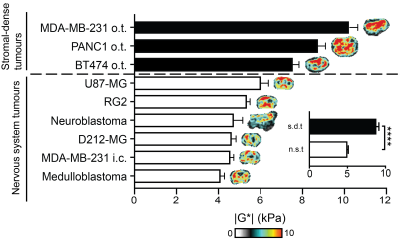 |
 Collagen is a major determinant of the viscoelastic properties of stromal-dense tumours: insights from pre-clinical MRE Collagen is a major determinant of the viscoelastic properties of stromal-dense tumours: insights from pre-clinical MRE
Jin Li, Konstantinos Zormpas-Petridis, Andreas Heindl, Jessica Boult, Craig Cummings, Jeffrey Bamber, Yinyin Yuan, Ralph Sinkus, Yann Jamin, Simon Robinson
The relationship of magnetic resonance elastography-derived viscoelasticity quantified in vivo in nine pre-clinical tumour models exhibiting varying degrees of stromal density was compared with histological assessments of cellularity, collagen and vessel density. Both cellularity and collagen deposition were identified as important determinants of the relative tumour stiffness.
|
16:39
|
0630.
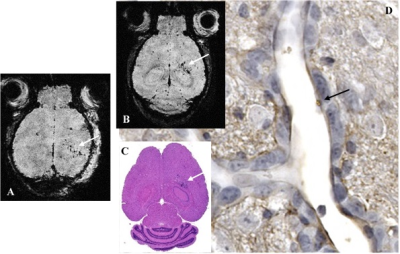 |
 Pre-existing inflammation in the brain promotes metastases invasion Pre-existing inflammation in the brain promotes metastases invasion
Dina Sikpa, Lisa Whittingstall, Jérémie P. Fouquet, Luc Tremblay, Réjean Lebel, Martin Lepage
We studied the effect of pre-existing inflammation on the genesis of brain metastases using MRI. Molecular MRI enhanced with VCAM-1 targeted microparticles of iron oxide enable the assessment of pre-existing vascular inflammation and then of metastasis implantation. The occurrence of brain metastases was increased by 2 fold when inflammation was present; this could be blocked with VCAM-1 antibody. This underlies the key role of VCAM-1 in tumor seeding to the brain, and suggests that preventive inflammation targeted treatment in cancer patients may minimize risks of brain metastasis.
|
16:51
|
0631.
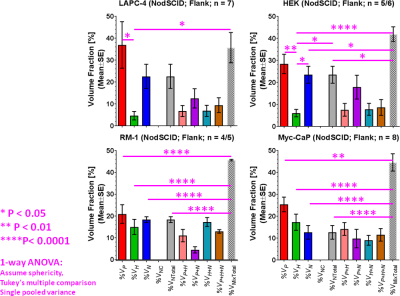 |
 Imaging the Interplay of Tumor Vascularity, Hypoxia, pHe, and Lactate Imaging the Interplay of Tumor Vascularity, Hypoxia, pHe, and Lactate
Ellen Ackerstaff, Natalia Kruchevsky, Ekaterina Moroz, H. Carl LeKaye, Kristen Zakian, SoHyun Han, HyungJoon Cho, Radka Stoyanova, Nirilanto Ramamonjisoa, Inna Serganova, Vladimir Ponomarev, Ronald Blasberg, Jason Koutcher
We characterized tumor vascularity, extracellular pH (pHe), and tumor lactate in various tumor models, focusing on prostate cancer. Spatial mapping demonstrated that vascular blood flow and permeability varied significantly in well-vascularized regions across tumor models and that the fraction of tumor necrosis was higher in the human than the murine models. The spatially most heterogeneous tumor type was characterized by the lowest lactate, a pHe of ~7.1 in well-vascularized regions, with lower pHe in less vascularized regions, and increasing lactate with decreasing vascular blood flow and permeability.
|
17:03
 |
0632.
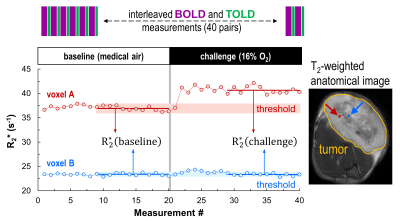 |
 Assessing Tumor Hypoxia Based on Hypoxic Gas Breathing Assessing Tumor Hypoxia Based on Hypoxic Gas Breathing
Donghan Yang, James Campbell III, Jenifer Gerberich, Heling Zhou, Ralph Mason
Tumor response to hypoxic gas breathing challenge was explored using oxygen-sensitive MRI in rat 13762NF breast tumors and compared with the more conventional hyperoxic gas breathing challenge. In viable tumor regions, blood oxygenation decreased with 16% O2breathing (demonstrated by an increase in R2*). A unique “on-and-off” pattern in T1-weighted signal intensity, which was closely related to tumor hypoxia level, was triggered by 16% O2 breathing but not 100% O2 breathing. When combined with hypoxic gas breathing, oxygen-sensitive MRI may reveal tumor hypoxia threshold, which is important for assessing the efficacy of hypoxia-activated prodrugs.
|
17:15
|
0633.
 |
Magnetic Resonance Angiography Reveals Increased Arterial Blood Supply and Tumorigenesis Following High Fat Feeding in a Mouse Model of Triple-negative Breast Cancer
Video Permission Withheld
Devkumar Mustafi, Rebecca Valek, Michael Fitch, Victoria Werner, Xiaobing Fan, Erica Markiewicz, Sully Fernandez, Marta Zamora, Jeffrey Mueller, Suzanne Conzen, Matthew Brady, Gregory Karczmar
Breast cancer is the most commonly diagnosed malignancy among women in the US. Epidemiology shows that a high animal fat diet increases risk of triple-negative breast cancer (TNBC). Our previous work examined the effect of pre-pubertal exposure to high dietary animal fat in the SV40Tag mouse model of TNBC. We showed that a high animal fat diet changes mammary fat composition and increases incidence and aggressiveness of mammary cancers in this model. Here, we demonstrate using MR angiography that changes in fat composition and cancer incidence are paralleled by increases in vascular density in the mammary gland.
|
17:27
|
0634.
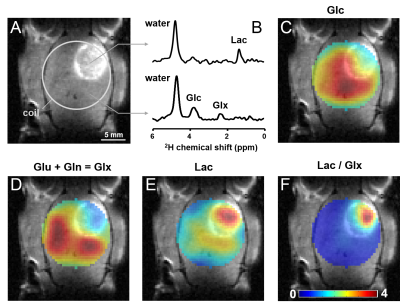 |
 Mapping of Glioma Metabolism Using In Vivo Deuterium Metabolic Imaging (DMI) Mapping of Glioma Metabolism Using In Vivo Deuterium Metabolic Imaging (DMI)
Henk De Feyter, Kevin Behar, Peter Brown, Douglas Rothman, Robin de Graaf
Deuterium Metabolic Imaging (DMI) is a novel approach providing high 3D spatial resolution metabolic data from both animal models and human subjects. DMI relies on 2H MRSI in combination with administration of 2H-labeled substrates. In a rat glioma model we show how DMI combined with administration of [6,6’-2H2]-glucose and [2H3]-acetate allowed spatial mapping of differences in metabolism between normal brain and glioma. DMI data after infusion of 2H-labeled glucose revealed high glucose uptake and lactate production but limited glucose oxidation in glioma. Furthermore, DMI revealed acute therapeutic effects of a drug (dichloroacetate) targeting glucose oxidation.
|
17:39
|
0635.
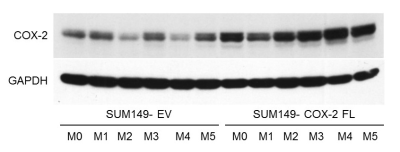 |
 COX-2 Alters the Metabolic Secretome in Triple Negative Human Breast Cancer Xenografts COX-2 Alters the Metabolic Secretome in Triple Negative Human Breast Cancer Xenografts
Santosh Bharti, Paul Winnard Jr., Yelena Mironchik, Louis Dore-Savard, Balaji Kirshnamachary, Zaver Bhujwalla
Tumor interstitial fluid (TIF) contains the tumor secretome and forms a critical component of the tumor microenvironment. Cyclooxygenase-2 (COX2) mediates the inflammatory response of cells and is upregulated in cancers. In cancers, COX-2 expression has been related to increased invasion and metastasis. Here, for the first time, using 1H MR spectroscopy we characterized changes in the metabolic patterns of TIF in tumors derived from triple negative SUM-149 human breast cancer cells with COX-2 overexpressed. COX-2 overexpression significantly altered several fundamental metabolic pathways. These data provide new insights into the role of COX-2 in tumor aggressiveness, and identify new metabolic targets.
|
17:51
|
0636.
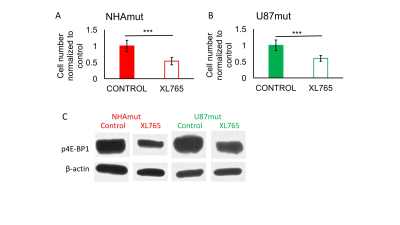 |
 PI3K/mTOR inhibition of IDH1 mutant glioma leads to reduced 2HG production that is associated with increased survival PI3K/mTOR inhibition of IDH1 mutant glioma leads to reduced 2HG production that is associated with increased survival
Georgios Batsios, Pavithra Viswanath, Anne Marie Gillespie, Elavarasan Subramani, Joanna Phillips, Russell Pieper , Sabrina Ronen
Mutant IDH1 produces the oncometabolite 2HG, which drives tumorigenesis in low-grade gliomas. One potential therapeutic option for such gliomas is treatment with a PI3K/mTOR inhibitor. Using cell models genetically-engineered to express mutant IDH1, we observed that PI3K/mTOR inhibition induced a reduction in 2HG levels in treated cells and tumors, that was associated with reduced cell proliferation and enhanced animal survival. The drop in 2HG was due to a reduction in its synthesis from both glucose and glutamine. Our study identifies MRS-detectable metabolic alterations that could serve as indicators of response for mutant IDH1 glioma patients undergoing treatment with PI3K/mTOR inhibitors.
|
18:03
|
0637.
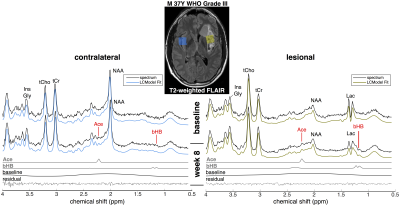 |
 Ketone measurement in human glioma following an Atkins-based diet Ketone measurement in human glioma following an Atkins-based diet
Adam Berrington, Karisa Schreck, Christopher Whitlow, Roy Strowd, Peter Barker
Recent studies have focused on the use of ketogenic diet (KD) in the treatment of glioma since tumor cells are heavily glucose-dependent. Here, we assess the ability of MRS to monitor KD-therapy in glioma patients. Using a semi-LASER sequence at 3 T, with fully simulated basis for spectral fitting, we measured increases in acetone and β-hydroxybutyrate after KD in tumor and contralateral brain. NAA concentration decreased in contralateral brain and there was an observed elevation of β-hydroxybutyrate in IDH-mutated gliomas; potentially indicating differential response to KD. These results indicate a potential for MRS in monitoring KD-based therapy in glioma.
|
|












